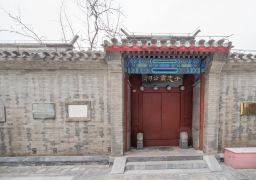Introducing the Xu Guo Stone Archway, commonly known as the Octagonal Memorial Archway. Constructed in October of the twelfth year of the Wanli era of the Ming Dynasty (1584 AD), it has a history of four hundred years. The Xu Guo Stone Archway is a rare example of an imitation wooden structure architecture in China. Its plan is a rectangular shape, with a north-south length of 11.54 meters, an east-west width of 6.77 meters, and a total height of 11.4 meters. The entire archway is composed of two front and back sections with three bays, four columns, and three stories, along with two side sections with a single bay, double columns, and three stories. All stone materials used are of high-quality, hard blue tea stone, with particularly thick and robust construction. Each of the eight columns is 50 centimeters square and over seven meters high. The beams, railings, brackets, and brackets are also made from large blocks of stone. Each of these large stones weighs four to five tons, and the precision in joining them in mid-air demonstrates the advanced architectural technology of the time.
The Xu Guo Stone Archway is exquisitely decorated with mythical birds, dragons, and animals. Twelve stone lions stand on the stone bases, lifelike and vivid. Inscriptions can be found on all sides of the archway. On the top layer of the front and back, and the third layer of the sides, there is a plaque with a double dragon border in the center, inscribed with the word ‘En Ron’, signifying the emperor’s ‘grace’ and ‘glory’. On the bottom layer, the word ‘Grand Scholar’ is engraved in a neat and upright manner. On the smaller arches at the front and back, it is inscribed with ‘Xu Guo, concurrently holding the positions of Grand Commandant, Grand Tutor to the Crown Prince, Minister of Rites, and Grand Scholar of Wuding Hall’. On the second layer of the front and back beams, there are large regular script characters inscribed with ‘First Study, Then Minister’ and ‘Senior Minister of the Platform’. ‘First Study, Then Minister’ promotes Xu Guo’s rise to officialdom through literary talent. ‘Senior Minister of the Platform’, ‘Platform’ refers to one of the ‘Three Platforms’. ‘Three Platforms’ originally refers to the names of constellations, and ancient people often used it to symbolize ‘Three Excellencies’ (Grand Tutor, Grand Preceptor, Grand Commandant) and ‘Three Isolates’ (Junior Grand Tutor, Junior Grand Preceptor, Junior Grand Commandant). Xu Guo, by this time, had been promoted to Junior Grand Commandant and was a Grand Isolate, hence the title.
All inscriptions on the stone archway are in the style of ‘Guan Ge Ti’ and ‘Bo Ke Shu’, and are said to be written by the calligrapher Dong Qichang of the Ming Dynasty. Dong’s calligraphy is rich in appearance and strong in bone, free and easy.
Fun fact: Xu Guo, styled Weizhen (1527-1596 AD), was from She County. He passed the imperial examination in the reign of Jiajing and served through the reigns of Jiajing, Longqing, and Wanli. During the Longqing era, the Ming Dynasty granted him the rank of first class to serve as an envoy to Korea. After Wanli ascended to the throne, he was promoted to Right Good Counselor and served as a daily lecturer. ‘Good Counselor’ was merely a title for serving the Crown Prince, while serving as a ‘daily lecturer’, discussing scriptures and politics by the emperor’s side, was an important step in his rapid rise to prominence. Soon after, he was indeed bestowed with the words ‘Responsible for Difficulties and Good’ by the emperor’s own brush, which he greatly favored and soared to high ranks.
In the 11th year of Wanli, he entered the court to assist in military affairs as the Minister of Rites and Grand Secretary of the Cabinet. He began to become an important minister in the cabinet of Emperor Zhu Yijun of the Ming Dynasty. Soon after, he was additionally appointed as the Grand Guardian of the Crown Prince and was transferred to be the Grand Secretary of Wenyuan Pavilion. In September of the 12th year of Wanli, due to his ‘meritorious decision-making’ in pacifying the rebellion in Yunnan, he was promoted to Junior Guardian and conferred as the Grand Secretary of Wuying Hall. He became the second-ranked assistant after the chief minister Shen Shixing. The Xu Guo Stone Archway began to be constructed one month after the pacification of the chaos in Yunnan. After the chaos in Yunnan was pacified, Emperor Wanli was extremely pleased and rewarded all officials. As an assistant minister, Xu Guo was praised as ‘cooperating loyally in strategizing and having outstanding achievements’. He received ‘special grace and rewards’. As can be seen from ‘Collected Works of Xu Wengong’, at this time, Xu Guo submitted two memorials in succession, repeatedly earnestly declining the ‘extraordinary grace and appointment’. The emperor did not permit it and issued an edict saying ‘do not stubbornly decline’. In this way, the Grand Secretary Xu received the imperial grace and returned to his hometown. He urged the prefectural and county officials, mobilized a large number of people, gathered craftsmen, and built the archway.









